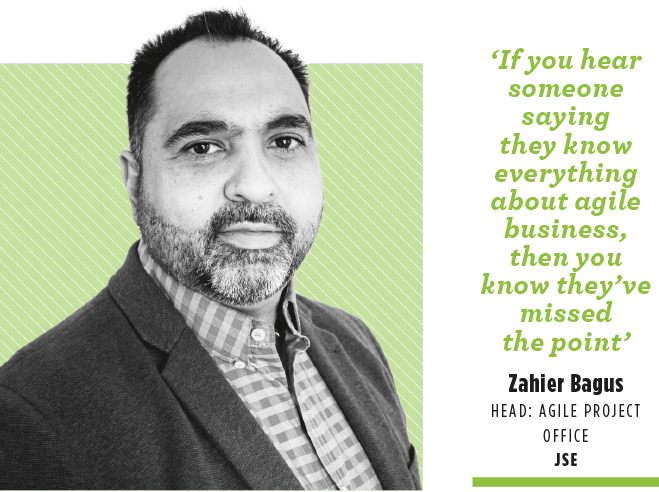Want to have a good chuckle? Go read the list of goals you set for your business (or yourself) in January 2020. The events of the past two-and-a-half years have upended almost every aspect of the operating environment. Zahier Bagus, Head of the JSE’s Agile Project Office, says that reactions to those disruptions ranged between two extremes.
‘At one end, people went in headlong and worked ridiculous hours,’ he says. ‘But others got smart about how they worked. They set up regular check-ins with their teams, kept the communication going, and moved quickly with the changes. The latter group – whether they realised it or not – were using practices and premises that came directly out of the Agile Business playbook.’
Business agility refers, in broad terms, to an organisation’s ability to adapt (internally and externally) to changes in an uncertain, ambiguous and complex market. It ensures that every aspect of the organisation – from leadership and governance to culture and strategy – delivers optimal value to all stakeholders.
It’s also just a good way of doing business. ‘It’s important for people in any organisation to continuously consider the way they work,’ says Bagus. ‘Are you being the best version of yourself to deliver a product of value to your customer? And can you improve on that?’
Yet while that may sound like common sense, it can be incredibly hard to transform a business to be more agile. ‘It’s difficult to get people to work differently,’ says Bagus. ‘In legacy organisations especially, it’s difficult to change mindsets and behaviours. But no matter the reason for your agile business transformation, the key thing is you can’t just do agile; you have to be agile.’
Agile thinking, he adds, is not the sole preserve of start-ups and tech companies. ‘There’s this idea that agile is just for the techies,’ he says. ‘But tech only really works if it aligns with the business strategy so, again, there has to be collaboration. In the old days a company would have its “bosberaad” at the start of the year, where a handful of people would come up with half-a-dozen great ideas, and then it was up to the business guys or the IT guys to figure out how to get it done. Of course, it wouldn’t get done – precisely because there was no collaboration.’
That, he says, is the biggest benefit of the agile methodology – it breaks down organisational silos and forces people to talk to each other. ‘There’s often a wariness around collaboration because while organisations want teamwork, they still tend to reward individuals,’ he says. ‘So many organisations are externally collaborative but internally competitive. Colleagues fight against each other for resources, money and time but, ultimately, they’re all working towards the same objective – to make the company successful.’
In an age of rapid change and frequent disruption, collaboration and agility are more important than ever. Change, however, is seldom easy. Bagus admits that the JSE’s journey to becoming an agile business has been challenging – as it is in most organisations. ‘What has helped a lot is creating communities of practice, both internally and externally,’ he says. ‘There’s no sharing of IP or worrying about NDAs. We don’t talk about what we do; we talk about how we do it. How have you managed to get agile financing working in your business? How are you getting people to talk to each other?’
Talking and sharing, he emphasises, are central to the agile methodology. ‘If you hear someone saying they know everything about agile business, then you know they’ve missed the point,’ he concludes. ‘You have to have a learning mindset – constantly.’









